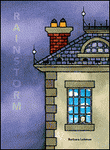There aren't many poetry board books out there, so I am delighted to be able to bring one of these titles to you today. Sharing poetry with very young children can be a wonderful experience for grownups, and their audience will enjoy experiencing language that has rhythm and rhyme.
Lullaby and Kisses Sweet: Poems to love with your baby
Selected By Lee Bennett Hopkins
Poetry Board Book
For infants to age 3
Abrams, 2015, 978-1-4197-1037-7
Sharing poems with very young children can be such a
joyous thing for an adult to do. Babies and toddlers have a natural affinity
for poetry because they are attracted to the cadences of the rhythm and rhyme.
In this
wonderful board book readers will find thirty original rhymes that Lee Bennett
Hopkins has carefully selected. They are arranged in five ‘chapters’ which are:
family, food, firsts, play and bedtime. The topics chosen for the poems
perfectly suit the interests and concerns of very young children, and are they
are paired with illustrations showing animal children and their families doing
everyday things.
In the first
section, family, there are poems about parents, grandparents and siblings. In
addition there is a poem called “My Name” by Madeline Kuderick. In this poem a
little cat child talks about how his name is “everywhere” on “wooden blocks, /
on my slippers, on my socks.” It is wonderful to see how the poem shows that the
little cat child is a vital part of the family world that he belongs to.
In the next
section, which is about food, there is a poem about how a child feels to be in
a high chair. The toddler is “the king of the upper air,” with “All below me in
my power.” There are also poems about breakfast cereal, milk, snack time,
spaghetti, and watermelon.
Wonderful poets
including Jane Yolen, J. Patrick Lewis, and Marilyn Singer wrote poems for this
collection. There is warmth, humor, and softness on the pages, and little
children will connect with the images and feelings that the poems and
illustrations evoke.









